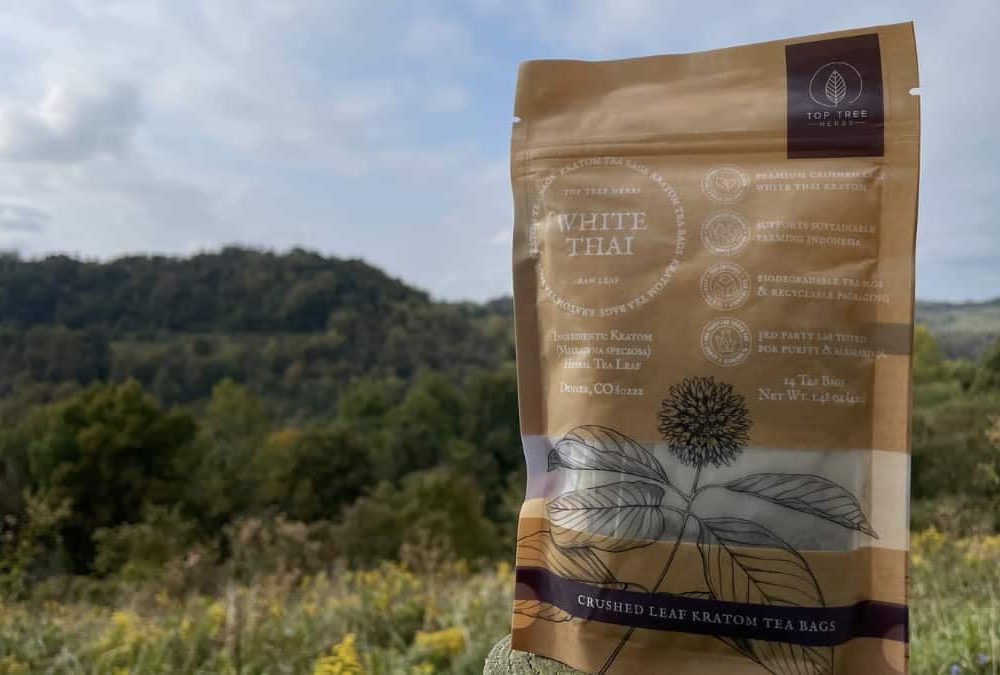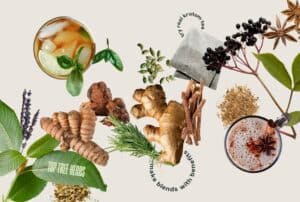White Thai Kratom
If you’re new to kratom, you may be feeling frustrated with the plethora of names for different kratom strains. With Red Maeng Da, Green OG Bali, White Borneo, Red Dragon, White Thai kratom and so on and so on, it can feel like you’re reading the results of a random word generator naming crayon colors. But fear not!
We’re here to help you make sense of the world of kratom tea!
In this post, we’ll be reviewing the White Thai Kratom strain. We’ll introduce kratom and the strain, and then get into the details to help you decide if this is the right strain for you!
What is Kratom?
Let’s start with a broader focus, and then work our way down to the specifics of the White Thai Kratom tea strain. “Kratom” is the colloquial name for both the whole plant and the leaves of the Mitragyna speciosa tree.
M. speciosa is an evergreen tree that grows in the tropical regions of Southeast Asia, from the base of the Himalayas to the Philippine Sea, and all the islands in between.
Kratom trees can grow upwards of 80 feet tall, and can produce tens of thousands of leaves in a very short time. This allows them to be harvested regularly. However, doing so is a grueling process that involves hard work (and absolutely no fear of heights).
In an effort to make a quick profit without working as hard, some kratom trees are simply cut down to harvest them. This is universally condemned, and not only hurts the environment, local ecosystems, and the economy, but is also illegal in some countries such as Thailand.
Nowadays, we all have to work together and take responsibility to ensure that we are participating in a sustainable economy. Double check that you are only purchasing sustainably harvested kratom products. If done mindfully, purchasing kratom can support the planting of more trees and the continual growth of forest ecosystems!
Traditional Use of Kratom
Chewing kratom leaves and drinking of kratom tea goes back at least 350 years. It was so important that it was elegantly carved on the wall of a stone buddhist temple in Thailand. Thailand maintains one of the richest traditional kratom cultures in the world (though most kratom in the US today comes from Indonesia).
That’s the earliest written record of kratom use, but it’s possible that this plant has been consumed by humans for much longer. Many experts have speculated that the use of kratom leaves goes back thousands of years.
In Thailand, most laborers and farmers chew kratom leaves or drink kratom tea every day. Working long hours in the beating sun wears them down, and they turn to kratom for a pick-me-up. In fact, their use of kratom follows the same pattern as the American habit of drinking coffee for increased productivity.
When a Thai farmer wants a quick energizing boost, they will simply pluck a leaf or two from a nearby kratom tree and chew it. They chew it up for a 5-30 seconds then quickly spit out and continue their work.
Traditional kratom tea in Thailand takes a bit more preparation. People typically pick kratom leaves in the morning and put them into a pot of boiling water. The decoction is left to steep over the fire for several hours, and is then shared with friends and family later in the day.
Kratom Tea vs. Kratom Powder
In the hundreds of years of traditional kratom consumption, rarely, if ever, have kratom leaves been swallowed. However, in the United States, swallowing kratom leaf powder is considered the norm. This diversion from the traditional kratom practices stems from both economic incentives and a lack of familiarity with kratom’s origins.
Almost all of the kratom that is sold in the United States first arrives on our shores in massive shipping containers. There is a strong economic incentive for kratom farmers to fit as much kratom into a shipping container as possible. This simply reduces their costs, as they pay per container for shipping. To pack kratom densely for shipping, it’s first washed, dried, and milled into a micronized powder.
Once the pulverized kratom lands in the US, there’s little educational material for consumers. Until recently, many kratom consumers didn’t realize that kratom came from a tree – the powder they bought was entirely disconnected from the plant and its origins. Kratom trees don’t grow in the US naturally and there isn’t any history of traditional use to learn from. All that many people knew was that the bag full of greenish powder had health benefits when consumed.
As a result, most kratom consumers in the US report that they just swallow the powder to consume it. No wonder a solid third of US kratom consumers report nausea and stomach issues!
Why Drink Kratom Tea
Drinking kratom tea is an easy decision. For starters, there’s no simple and delicious way to swallow kratom powder. Plus, as many of us who first tried kratom as a powder know, it isn’t always easy on the GI tract.
Yet you don’t need powder or extracts to achieve the desired results and benefits that come with kratom!
When you brew kratom tea, you extract the alkaloids and leave the plant material in the tea bag. It’s an acquired taste, but still much more palatable than powder. Like espresso and other bitter drinks, it can take some time getting used to. Once you’ve developed a taste for it, you’ll cherish its full profile: its aroma, its color, and its symphony of flavors.
Brewed correctly, kratom tea is every bit as strong as swallowing the equivalent amount of kratom powder. Just like making coffee beverages, brewing kratom tea is an art. Luckily, it’s not too hard to get good at. Stick around to the end of the post for our full guide on making the perfect White Thai Kratom tea.
Kratom Strains
As we mentioned at the beginning of this post, kratom comes from one tree species: Mitragyna speciosa. Just as cannabis is all sourced from the same plant species but can have different effects for each strain, kratom can have a variety of effects despite all coming from the same species of tree. Like cannabis, each kratom tree has unique qualities which come from variables such as nutrient levels, sunlight, and geographical location.
One of the most important factors that contribute to the effects of each kratom tree is its geographical location. In fact, some studies have shown that different kratom trees grown in different locations can have completely different alkaloid profiles.
A total of 40 different alkaloids have been found among kratom trees. Each tree has six to eight dominant alkaloids, and these combinations of alkaloids contribute to the range of effects you can get from your kratom tea.
The quickest and easiest way to determine what type of kratom you’re looking for is to know the difference between the three major vein colors. These vein colors are white, green, and red. Young kratom leaves have a red vein that matures into a darker green color.
After the leaves are picked, they are separated and left to cure differently. The leaves that ferment longest have a darker color than those left to bleach in the sun. All these variables together account for the white, green, and red color categorization.
White Vein Kratom Effects
White vein kratom is associated with energizing and uplifting qualities. Those who are looking for coffee alternatives without caffeine should try white vein kratom strains. The effects of white vein kratom are energizing and may help with clarity of thought.
The benefits of white vein kratom are usually found at lower serving sizes. The effects of consuming a moderate to high amount of white vein kratom may be more like the effects of green and red vein kratom.
White Thai Kratom Effects
White Thai kratom is a powerful Thai landrace. It’s renowned for its strength, and it’s good to be mindful of this when drinking White Thai tea. Start with a small serving size and work your way up to the amount that’s right for you. If you’re using kratom tea bags, try starting with just one tea bag, even if you’re used to using three or more!
White Thai kratom was our go-to strain for late-night study sessions and meeting deadlines. While it amped us up and gave us the push needed to succeed, we also liked the fact that it didn’t keep us up after our tasks were complete, tossing and turning in bed, like coffee did.
White Thai Kratom Tea Flavor
Like most kratom teas, the White Thai kratom strain can broadly be generalized as earthy and bitter. Its aroma is reminiscent of an autumn forest, still dry before the winter rains. After pairing our White Thai kratom tea with many flavors, we decided that it paired perfectly with a dash of all natural Acai Berry flavoring.
The sweet and fruity flavor of the Acai Berry softens the bitterness of the kratom, and brings out the more enjoyable notes in the White Thai. Overall, the Acai Berry is “berry-ly” noticeable in your finished cup of tea. It simply serves to ramp up the good flavors of the kratom tea while softening that first, sharp bitter note that hits your tongue.
Where to Buy White Thai Kratom Tea?
Your first consideration when buying kratom tea should be that it was sustainably harvested, lab tested, and coming from a reputable kratom vendor. In terms of quality, being free from pathogenic bacteria, fungi, heavy metals, and other contaminants is square one.
Luckily, this is easily done by looking for the stamp of approval by the American Kratom Association (AKA), which ensures that vendors follow current Good Manufacturing Practices (cGMP).
Once you’ve checked to make sure that your kratom is clean and ethically sourced, you should then try to find crushed leaf kratom. Most retail shops don’t sell crushed leaf kratom, which is why we recommend shopping online.
Even online you should look carefully. Many vendors sell micronized powder as “kratom tea.” This powder makes for a gritty, sandy, and nasty tea. In fact, it is more aptly called a “slurry,” not “tea,” as you still end up swallowing kratom leaf powder!
In short, and probably as no surprise to you, we recommend you buy our kratom tea bags. The kratom is sustainably harvested, lab checked and approved by the AKA, and processed in cGMP facilities.
We only use premium, crushed leaf kratom in our tea bags. That means you’re only drinking the tea, and not the leaf. Just as it has been done traditionally for thousands of years.

How to Brew Kratom Tea
Now, you may be thinking, “doesn’t traditional kratom tea take hours to brew?” That’s correct, but we’ve managed to speed things up with a little chemistry help.
The point of brewing a tea is to get the kratom alkaloids out of the leaf and into your water. To speed things up, we simply need to increase the heat, pressure, and acidity of the water. Luckily, this is easy to do with the help of a thermos and lemon juice.
- Bring water to a boil.
- Squeeze a couple tsp of lemon juice into your thermos and add your kratom tea bags. We recommend you start with one tea bag, and work your way up to the amount you’re comfortable with, especially if you’re new to kratom.
- Pour your boiling water into your thermos.
- Cap your thermos and let your tea bags steep for at least 20 minutes.
- Pour into a tea mug, sweeten to taste, let cool, and enjoy!
Pro Brewing Tips
Tip 1: Add an herbal tea bag into your mug to add some flavor! We recommend our Cacao Uplift white vein blend for a solid motivational boost or our Holy Peach kratom blend for a balanced brew that’s full of flavor.
Tip 2: You can rebrew your kratom tea bags a second time for a slightly weaker cup of tea! We especially recommend re-brewing your kratom tea bags if you are using two or more in your thermos. Simply follow the same instructions you did for the first brew and enjoy.






